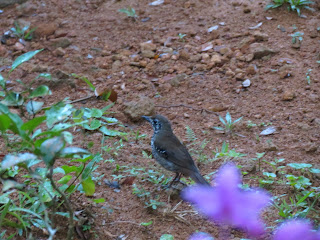At the start of the year we had planned to visit Sinharaja National Park, but other things popped up and we thought we would not be able to do that, so we would visit Horton Plains instead. Almost at the end of the trip my father came to me and said "We have an extra few days now, so would you like to visit Sinharaja?" I said yes and so we went. It was a long drive and the last part of the road was very thin and bumpy, but eventually we got there, ate dinner and went to sleep. We woke up to the sound of blue magpies calling . . .
After getting ready and grabbing my camera I quickly ventured outside, to see a lifer flying past me, my first Sri Lankan blue magpie!
And it wasn't my last, either! Many of them flew through the air and perched on trees and tables, their calls filling the forest. Along with the magpies were shyer spot-winged thrushes darting around on the ground, and a giant squirrel in a tree. Soon we had our breakfast and went on a walk through the forest.
This spot-winged thrush was standing in front of some stairs leading down to the forest
First we had to go to the park visitor center to get permission to enter the national park and also to get a guide. While on the way we spotted an emerald dove and what I think is a Sri Lankan kangaroo lizard before reaching the center. Here we met our guide and went forward through the forest. Almost immediately I spotted a lifer, a yellow-browed bulbul, along with a black-capped bulbul which darted into the forest too quickly for a photo.
This yellow-browed bulbul managed to sit still long enough for me to get this shot
Finally, a dark-fronted babbler that let me get a photo!
We walked further along, spotting a flock of dark-fronted babblers that let me get a rather blurry photo, as well as a few more skinks and kangaroo lizards. Finally we got to the entrance of the park. We walked a bit further. Suddenly chuckling calls seemed to fill the air. Our guide motioned for us to stop as, very quickly, something appeared in a tree . . .
AN ASHY-HEADED LAUGHINGTHRUSH!
We walked further on to the screeches of flying Layard's parakeets and the calls of black-capped and yellow-browed bulbuls. We stopped at a spot where the Sri Lankan frogmouth was supposed to roost, but could not see it. We did bump into a besra (another lifer) though, as it perched on a branch above the canopy, looking for prey, as well as a very tame Sri Lankan junglefowl that sat behind a bench while I ate a snack on it (the bench, not the junglefowl).
A besra waiting for breakfast
We stopped suddenly again to the calls of birds in the trees. It was a feeding flock of birds and it was heading our way. In Sinharaja, if you want to see all the endemic birds you basically HAVE to see a feeding flock. Many different birds gather into flocks that sweep through the forest, crossing trails and feeding on whatever they can find. These include many of the endemics. I spotted a pair of crested drongos in a tree. These birds are known for normally being the first birds in a feeding flock to cross the road/track. I snapped a few photos and then, suddenly . . .
The birds all headed back into the forest.
We walked further along, spotting a few more Layard's parakeets darting overhead. Finally, we were almost at the end of the track we had been walking on when birdcalls filled the air again. This time, they didn't grow softer. This time they loudened. As a lifer black-naped monarch darted into the forest I knew. We were in a feeding flock!
A rufous babbler that was one of the many in the flock
The flock was almost completely of rufous babblers which moved up and down the road, feeding in trees. A few ashy-headed laughingthrushes flew across the road, and a yellow-browed bulbul came out from behind a bush. True, it was a small flock, but it was a flock. We walked further down and finally got great views of a lone crested drongo that had forgotten to move on with the flock.
It was a great day, but unfortunately enough it was over. We said our goodbyes and went down along the road, stopping for one last lifer in a pine tree, a black bulbul.
WE'LL BE BACK!









No comments:
Post a Comment